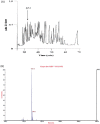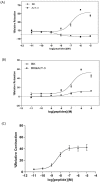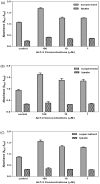Identification and functional analysis of a novel tryptophyllin peptide from the skin of the red-eye leaf frog, Agalychnis callidryas
- PMID: 25561903
- PMCID: PMC4279096
- DOI: 10.7150/ijbs.10143
Identification and functional analysis of a novel tryptophyllin peptide from the skin of the red-eye leaf frog, Agalychnis callidryas
Abstract
Amphibian skin has proved repeatedly to be a largely untapped source of bioactive peptides and this is especially true of members of the Phyllomedusinae subfamily of frogs native to South and Central America. Tryptophyllins are a group of peptides mainly found in the skin of members of this genus. In this study, a novel tryptophyllin (TPH) type 3 peptide, named AcT-3, has been isolated and structurally-characterised from the skin secretion and lyophilised skin extract of the red-eye leaf frog, Agalychnis callidryas. The peptide was identified in and purified from the skin secretion by reverse-phase HPLC. MALDI-TOF mass spectrometry and MS/MS fragmentation sequencing established its primary structure as: pGlu-Gly-Lys-Pro-Tyr-Trp-Pro-Pro-Pro-Phe-Leu-Pro-Glu, with a non-protonated molecular mass of 1538.19Da. The mature peptide possessed the canonical N-terminal pGlu residue that arises from post-translational modification of a Gln residue. The deduced open-reading frame consisted of 63 amino acid residues encoding a highly-conserved signal peptide of approximately 22 amino acid residues, an intervening acidic spacer peptide domain, a single AcT-3 encoding domain and a C terminal processing site. A synthetic replicate of AcT-3 was found to antagonise the effect of BK on rat tail artery smooth muscle and to contract the intestinal smooth muscle preparations. It was also found that AcT-3 could dose-dependently inhibit the proliferation of human prostate cancer cell lines after 72h incubation.
Keywords: Agalychnis callidryas; anticancer effect; bradykinin antagonist; myotropic activities; proline-rich peptide.
Conflict of interest statement
Competing Interests: The authors have declared that no competing interest exists.
Figures







Similar articles
-
AcT-2: a novel myotropic and antimicrobial type 2 tryptophyllin from the skin secretion of the Central American red-eyed leaf frog, Agalychnis callidryas.ScientificWorldJournal. 2014 Feb 13;2014:158546. doi: 10.1155/2014/158546. eCollection 2014. ScientificWorldJournal. 2014. PMID: 24693226 Free PMC article.
-
PsT-1: a new tryptophyllin peptide from the skin secretion of Waxy Monkey Leaf Frog, Phyllomedusa sauvagei.Regul Pept. 2013 Jun 10;184:14-21. doi: 10.1016/j.regpep.2013.03.017. Epub 2013 Mar 19. Regul Pept. 2013. PMID: 23518460
-
Molecular cloning of a novel tryptophyllin peptide from the skin of the orange-legged monkey frog, Phyllomedusa hypochondrialis.Chem Biol Drug Des. 2014 Jun;83(6):731-40. doi: 10.1111/cbdd.12287. Epub 2014 May 13. Chem Biol Drug Des. 2014. PMID: 24821135
-
Tachykinins and other biologically active peptides from the skin of the Costa Rican phyllomedusid frog Agalychnis callidryas.Peptides. 1997;18(3):367-72. doi: 10.1016/s0196-9781(96)00342-7. Peptides. 1997. PMID: 9145422
-
PdT-2: a novel myotropic type-2 tryptophyllin from the skin secretion of the Mexican giant leaf frog, Pachymedusa dacnicolor.Peptides. 2009 Aug;30(8):1557-61. doi: 10.1016/j.peptides.2009.04.019. Epub 2009 May 7. Peptides. 2009. PMID: 19427344
Cited by
-
Baltikinin: A New Myotropic Tryptophyllin-3 Peptide Isolated from the Skin Secretion of the Purple-Sided Leaf Frog, Phyllomedusa baltea.Toxins (Basel). 2016 Jul 8;8(7):213. doi: 10.3390/toxins8070213. Toxins (Basel). 2016. PMID: 27399779 Free PMC article.
-
The peptide secreted at the water to land transition in a model amphibian has antioxidant effects.Proc Biol Sci. 2021 Nov 10;288(1962):20211531. doi: 10.1098/rspb.2021.1531. Epub 2021 Nov 10. Proc Biol Sci. 2021. PMID: 34753356 Free PMC article.
-
Ex Vivo Smooth Muscle Pharmacological Effects of a Novel Bradykinin-Related Peptide, and Its Analogue, from Chinese Large Odorous Frog, Odorrana livida Skin Secretions.Toxins (Basel). 2016 Sep 27;8(10):283. doi: 10.3390/toxins8100283. Toxins (Basel). 2016. PMID: 27690099 Free PMC article.
References
-
- Savage JM. The Amphibians and Reptiles of Costa Rica: a herpetofauna between two continents, between two seas. Salt Lake City, United States: University of Chicago Press books; 2002. pp. 122–158.
-
- Clark BT. The natural history of amphibian skin secretions, their normal function and potential medicinal applications. Biological Reviews of the Cambridge Philosophical Society. 1997;72:365–379. - PubMed
-
- Toledo RC, Jared C. Cutaneous granular glands and amphibian venoms. Comparative Biochemistry and Physiology Part A: Physiology. 1995;111:1–29.
-
- Elkan E. Mucopolysaccarides in the anuran defence against dessication. Journal of Zoology. 1968;155:9–53.
-
- Bevins CL, Zasloff M. Peptides from frog skin. Annual Review of Biochemistry. 1990;59:395–414. - PubMed
Publication types
MeSH terms
Substances
LinkOut - more resources
Full Text Sources
Other Literature Sources

